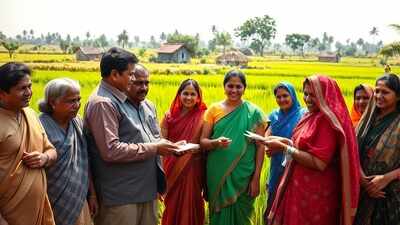ARTICLE AD BOX

Rural India i.e. Bharat, is at a crossroad and needs to prioritise on a borrower-first lens. (AI image)
By Mayur ModiRural India i.e. Bharat, is at a crossroad and needs to prioritise on a borrower-first lens. Underlying trends indicate such a strategy would ensure rural and retail credit systems focus on income generation as well as lifecycle engagement.
An uptick in delinquencies has caused concerns across all sub-sectors of Indian financial markets. According to data from TransUnion CIBIL, delinquency rate for small-ticket personal loans touched 5.4% in early 2024. Rural districts contributed a disproportionate share of this stress. The RBI’s Financial Stability report for December 2024 too had raised concerns about rising delinquencies in the micro-finance sector.
Several newspaper reports have highlighted the concerns of rising delinquencies and several of these reports have indicated even private banks witnessing a spurt in loans turning sour.Pitfalls of High-Velocity Credit ExpansionA great degree of thought has gone into volume-led financial inclusion, however such a phase of stress is a sobering reminder on why inclusion without prudence is never sustainable. Over the past decade, India's push for financial deepening has been commendable.
NBFCs, fintechs, and MFIs played a crucial role in expanding credit access to underserved geographies. However, the growth model leaned heavily on speed—fast approvals, thin credit filters, and a reliance on digital data proxies rather than real-world cash flows.Such a model worked in stable conditions, but rural borrowers are particularly vulnerable to cyclical and economic shocks of inflation, climate events, and even medical emergencies.
With little to no financial buffers, repayment chains are brittle to the vagaries of life.What’s missing is the foundational principle we apply in corporate finance: lending should be backed by revenue visibility and viability. If corporate loans can be underwritten with strict scrutiny and thorough assessments, why not retail and rural products such as personal loans, credit cards, and even SME loans? Many lenders have systems in place to assess a borrower’s ability, but often the need to comply with steep targets results in dilution of qualitative risk assessment frameworks.
Setting a borrower-first philosophyBe it rural or urban lending, the loan documentation process involves KYC (Know Your Customer) processes and strict rigour. To lenders, however, it should not only be about knowing the “known” but also attempting to know the “unknowns” with their borrowers. With KYC processes, borrowers generally learn about the borrower’s residence, income and personal details. But more data provides newer and more relevant dimensions.
An example could be farm-loans where lenders assessing underwriting a loan where productive assets such as motor pumps, livestock, agro-inputs, or other equipment could be considered a secure or quasi-secured credit rather than a personal loan. That is because productive assets generate cash flow which in turn enhances repayment ability.Second, risk assessment becomes critical when dealing in largely heterogeneous geographies.
In such cases, digital credit scores are useful, but insufficient because availability of data is over-hyped in the rural hinterlands. Operating in such geographies necessitates processes such as on-ground verification, household-level surveys, and even community references which can help build a more accurate picture.
When it comes to SME lending, a lender does more than just rely on a promoter’s reputation. A lot can be done even after a loan gets disbursed. Post-disbursal engagement could mean guidance for borrowers or even periodic review of loan accounts. Such exercises will not only produce reliable data for a lender but also instill confidence among rural customers. Building an ecosystem: From product to partnershipA borrower-first model also demands a shift in how products are designed and supported. Repayment terms, for instance, could reflect income realities.
Rural loans including farm/agri loans often involve the vagaries of seasonal variability. So, expecting them to service monthly EMIs can at times be unrealistic. Repayment schedules aligned to harvest cycles or business cash flows could therefore significantly improve repayment discipline.Insurance is another critical lever. Bundling credit with simple, claim-efficient protection—whether health, life, or crop insurance—can help preserve repayment capacity during unforeseen events.
Moreover, data sharing and cross-institution coordination can play a transformative role. If borrowers are offered pre-approved top-ups or restructuring options based on performance—similar to MSME credit enhancement frameworks—it builds trust and prevents default escalation.The most important shift could be in how we measure success. Today, credit penetration is measured by disbursal volumes. In a borrower-first world, we could measure impact— for instance, how many loans resulted in income gains? Or, business creation or financial stability.
Such an ecosystem is welcoming of banks, NBFCs, Fintechs, and the regulators. Ultimately it is the culmination of strong people-processes aligned with right digital infrastructure that we can make banking work for all, especially in the rural markets.
While delinquencies are concerning, India’s rural credit market is at a crossroad. We can continue to expand credit mechanically and risk future waves of default. Or we can recalibrate, placing the borrower at the centre, and build a model of lending that is resilient, responsible, and regenerative. The principles of good lending should ideally not change with ticket size. So, let us know our borrowers - slightly more than what the process mandates; and treat lending as more than just a transaction.The author is Co-founder & Co-CEO, Moneyboxx Finance Limited



.png)
.png)
.png)
















 3 days ago
6
3 days ago
6









 English (US) ·
English (US) ·